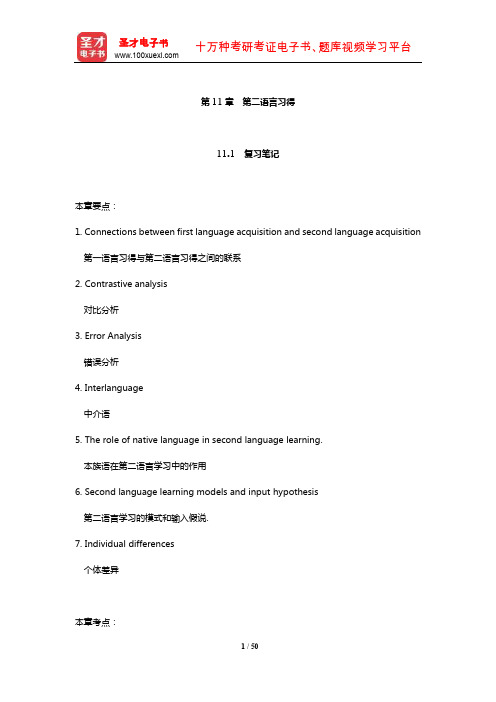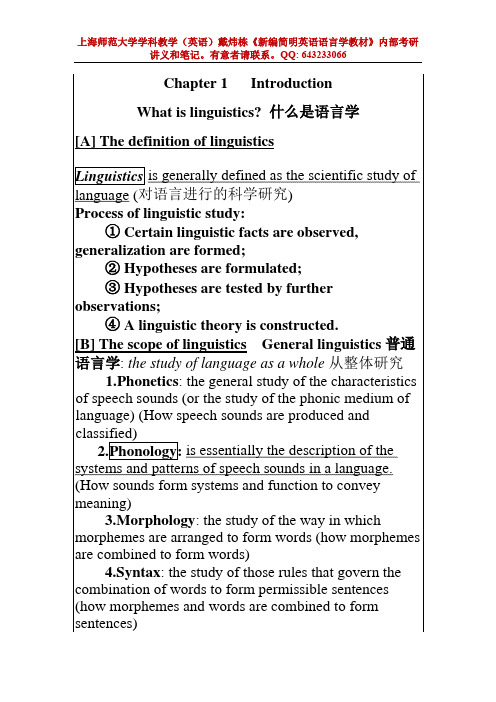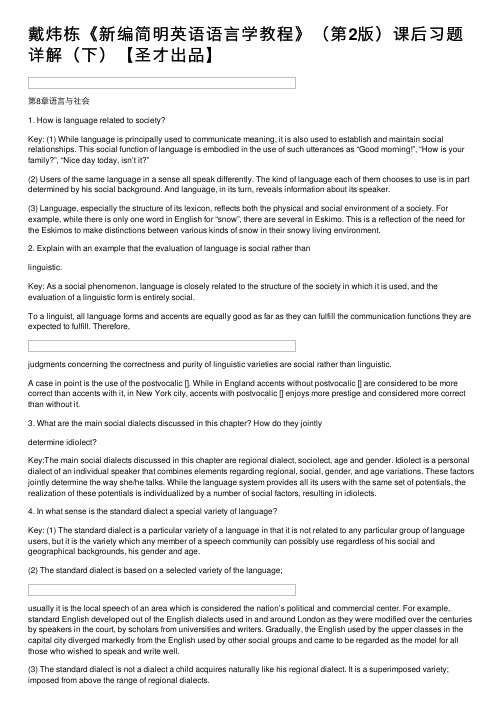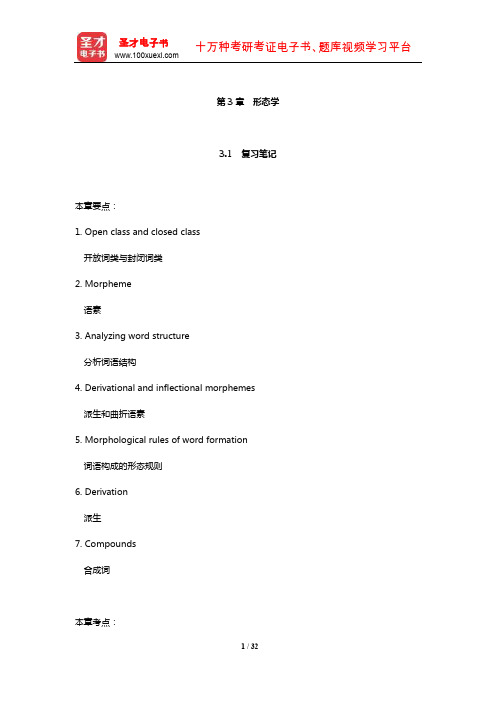戴炜栋《新编简明英语语言学教程》笔记和课后习题(含考研真题)详解(音位学)【圣才出品】
戴炜栋《新编简明英语语言学教程》笔记和课后习题(含考研真题)详解(第二语言习得)【圣才】

第一语言习得与第二语言习得之间的联系 2. Contrastive analysis
对比分析 3. Error Analysis
错误分析 4. Interlanguage
中介语 5. The role of native language in second language learning.
本族语在第二语言学习中的作用 6. Second language learning models and input hypothesis
1. Overgeneralization 2. Cross-association V. Interlanguage VI. The role of native language in second language learning VII. Second language learning models and input hypothesis VIII. Individual differences 1. Language aptitudes 2. Motivation 3. Learning strategies 4. Age of acquisition 5. Personality IX. Second language acquisition and its pedagogical implications
第二语言习得(SLA )在二十世纪七十年代左右被正式确立为一门学科,是指对一个人习 得其母语之后如何习得一门第二语言的系统研究。
上海师范大学学科教学(英语)戴炜栋《新编简明英语语言学教材》内部考研讲义和笔记

[C] Some important distinctions in linguistics ① Prescriptive vs. Descriptive 规定性与描写 性 ② Synchronic vs. Diachronic 共时性与历时性 (现代英语多研究共时性) The description of a language at some point in time; The description of a language as it changes through time.
上海师范大学学科教学(英语)戴炜栋《新编简明英语语言学教材》内部考研 讲义和笔记。有意者请联系。QQ: 643233066
What is language? 什么是语言 [A] The definition of language Language is a system of arbitrary vocal symbols used for human communication. (语言是一个具有任意性、 用于人类交流的语音符号系统。) a) System: combined together according to rules (根据 规则组合在一起) b) Arbitrary: no intrinsic connection between a linguistic symbol and what the symbol stands for(语言符号和符 号所代表的事物之间没有内在的必然的联系) c) Vocal: the primary medium is sound for all languages (所有语言的首要媒介都是声音) d) Human: language is human-specific (语言是人类所 独有的) [B]Design features (unique properties): the defining properties of human language that distinguish it from any animal system of communication (识别特征是指人类 语言区别于任何动物交际系统的本质特征) ①Arbitrariness(任意性) There is no logical or natural connection between a linguistic form (either sound or word) and its meaning. While language is arbitrary by nature, it is not entirely arbitrary.(意义和语音之间没有什么逻辑的联系;虽 然是任意性的,但并非完全任意) a) echo of the sounds of objects or activities: onomatopoeic words (拟声词) b) some compound words (某些复合词) ②Productivity(能产性,创造性)
戴炜栋《新编简明英语语言学教程》(第2版)课后习题详解(下)【圣才出品】

戴炜栋《新编简明英语语⾔学教程》(第2版)课后习题详解(下)【圣才出品】第8章语⾔与社会1. How is language related to society?Key: (1) While language is principally used to communicate meaning, it is also used to establish and maintain social relationships. This social function of language is embodied in the use of such utterances as “Good morning!”, “How is your family?”, “Nice day today, isn’t it?”(2) Users of the same language in a sense all speak differently. The kind of language each of them chooses to use is in part determined by his social background. And language, in its turn, reveals information about its speaker.(3) Language, especially the structure of its lexicon, reflects both the physical and social environment of a society. For example, while there is only one word in English for “snow”, there are several in Eskimo. This is a reflection of the need for the Eskimos to make distinctions between various kinds of snow in their snowy living environment.2. Explain with an example that the evaluation of language is social rather thanlinguistic.Key: As a social phenomenon, language is closely related to the structure of the society in which it is used, and the evaluation of a linguistic form is entirely social.To a linguist, all language forms and accents are equally good as far as they can fulfill the communication functions they are expected to fulfill. Therefore,judgments concerning the correctness and purity of linguistic varieties are social rather than linguistic.A case in point is the use of the postvocalic []. While in England accents without postvocalic [] are considered to be more correct than accents with it, in New York city, accents with postvocalic [] enjoys more prestige and considered more correct than without it.3. What are the main social dialects discussed in this chapter? How do they jointlydetermine idiolect?Key:The main social dialects discussed in this chapter are regional dialect, sociolect, age and gender. Idiolect is a personal dialect of an individual speaker that combines elements regarding regional, social, gender, and age variations. These factors jointly determine the way she/he talks. While the language system provides all its users with the same set of potentials, the realization of these potentials is individualized by a number of social factors, resulting in idiolects.4. In what sense is the standard dialect a special variety of language?Key: (1) The standard dialect is a particular variety of a language in that it is not related to any particular group of language users, but it is the variety which any member of a speech community can possibly use regardless of his social and geographical backgrounds, his gender and age.(2) The standard dialect is based on a selected variety of the language;usually it is the local speech of an area which is considered the nation’s political and commercial center. For example, standard English developed out of the English dialects used in and around London as they were modified over the centuries by speakers in the court, by scholars from universities and writers. Gradually, the English used by the upper classes in the capital city diverged markedly from the English used by other social groups and came to be regarded as the model for all those who wished to speak and write well.(3) The standard dialect is not a dialect a child acquires naturally like his regional dialect. It is a superimposed variety; imposed from above the range of regional dialects.(4) The standard dialect has some special functions. Also designated as the official or national language of a country, the standard dialect is used for such official purpose as government documents, education, news reporting; it is the language used on any formal occasions.5. What is register as used by Halliday? Illustrate it with an example of your own. Key: According to Halliday, “Language varies as its function varies; it differs in different situations.” The type of language which is selected as appropriate to the type of situation is a register. Halliday further distinguishes three social variables that determine the register: field of discourse, tenor of discourse, and mode of discourse.For example, a lecture on biology in a technical college could be identifiedas:Field: scientific (biological)Tenor: teacher-students (formal, polite)Mode: oral (academic lecturing)6. What linguistic features of Black English do you know? Do you think Black English is an illogical and inferior variety of English? Why (not)?Key: (1) Linguistic features of Black English:Phonological features: simplification of consonant clusters at the end of a word. According to this consonant deletion rule, the final-position consonants are often deleted; thus “passed” is often pronounced [], mend [], desk [], and told [].Syntactic features one: the deletion of link verb “be”. In Black English, we often come across many sentences without copula verb: “They mine”, “You crazy”, “Her hands cold”, and “That house big”. In fact, copula verb deletion is not a unique feature of Black English, it is often found in other dialects of English and in languages like Russian and Chinese.Syntactic features two: the use of double negation structure. e.g.He don’t know nothing. (He doesn’t know anything.)I ain’t afraid of no ghosts. (I am not afraid of ghosts.)Some people consider these sentences illogical because they claim that two negatives make positive. But in fact, such double negative constructions werefound in all dialects of English of earlier period.(2) I don’t think Black English is an illogical and inferior variety of English.Linguists are agreed that no variety of a language is inherently better than any other. They insist that all languages and all varieties of a particular language are equal in that they quite adequately serve the needs of those who use them. The only exception they recognize are pidgins, which are by definition restricted varieties, or the varieties we associate with people who are impaired in some way, e.g. certain mentally or physically handicapped people. American English is considered “better”only in a social sense: it has a preferred status; it gives those who use it certain social advantages; and it increases their life chances. Black English, being a nonstandard variety, tends to produce the opposite effect. These are some of the consequences that follow from elevating one variety and denigrating others, but there is no reason to suppose that any one of the varieties is intrinsically more worthy than any other.7. What peculiar features does pidgin have?Key: A pidgin is a special language variety that mixes or blends languages and it is used by people who speak different languages for restricted purposes such as trading. Pidgin arose from a blending of several languages such as Chinese dialects and English, African dialects and French. Usually a European language serves as the basis of the pidgin in the sense that some of its grammar and vocabulary is derived from the European language used by traders andmissionaries. Pidgins typically have a limited vocabulary and a reduced grammatical structure characterized by the loss ofinflection, gender and case. The “simplified” variety performs its function as trading and employment.8. How do bilingualism and diglossia differ, and what do they have in common? Key: Differences:(1)Bilingualism refers to the situation that two languages are used side by side with each having a different role to play; and language switching occurs when the situation changes.(2)Diglossia, refers to a sociolinguistic situation similar to bilingualism. In a diglossic situation, two varieties (high variety and low variety) of a language, instead of two different languages, exist side by side throughout the community, with each having a definite role to play. One of the most important features of diglossia is the specialization of function of the two varieties. Each variety is the appropriate language for certain situations with very slight overlappings.Similarity:The two languages of bilingualism and two varieties of diglossia exist side by side and have different role to play as situation changes.。
戴炜栋《新编简明英语语言学教程》笔记和课后习题(含考研真题)详解(音位学)【圣才出品】

戴炜栋《新编简明英语语⾔学教程》笔记和课后习题(含考研真题)详解(⾳位学)【圣才出品】第2章⾳位学2.1 复习笔记本章要点:1. Speech Organs发⾳器官2. Distinction, Classification and the Criteria of Description between Constants and Vowels辅⾳和元⾳的区别、分类及描写规则3. Phonemes and Allophones⾳位和⾳位变体4. Phonological Rules and Distinctive Features⾳系规则和区别特征5. Syllable Structure, Stress and Intonation⾳节结构、重⾳和语调本章考点:1. 语⾳学语⾳学的定义;发⾳器官的英⽂名称;英语辅⾳的定义、发⾳部位、发⾳⽅法和分类;英语元⾳的定义和分类、基本元⾳;发⾳语⾳学;听觉语⾳学;声学语⾳学;语⾳标记,国际⾳标;严式与宽式标⾳法。
2. ⾳系学⾳系学的定义;⾳系学与语⾳学的联系和区别;⾳素、⾳位、⾳位变体、最⼩对⽴体、⾃由变体的定义;⾃由变体;⾳位的对⽴分布与互补分布;区别性特征;超语段⾳位学;⾳节;重⾳(词重⾳、句⼦重⾳);⾳⾼和语调。
本章内容索引:I. The phonic medium of languageII. Phonetics1. The definition of phonetics2. Three research fields3. Organs of speech▼4. Voiceless sounds▼5. Voiced sounds6. Orthographic representations of speech sounds—broad and narrow transcriptions7. Classification of English speech sounds(1) Definition(2) Classification of English consonants(3) Classification of English vowelsIII. Phonology1. Relationship between Phonology and phonetics2. Phone, phoneme3. Allophone4. Some rules in phonology(1) Sequential rules(2) Assimilation rule(3) Deletion rule5. Supra-segmental features—stress, tone, intonation(1) Stress(2) Tone(3) IntonationI. The phonic medium of language(语⾔的语⾳媒介)II. Phonetics(语⾳学)1. The definition of phonetics(语⾳学的定义)Phonetics is defined as the study of the phonic medium of language; it is concerned with all the sounds that occur in the world’s languages.语⾳学被定义为对语⾔的语⾳媒介的研究;它涉及所有出现在世界语⾔中的声⾳。
戴炜栋《新编简明英语语言学教程》(第2版)笔记和课后习题(含考研真题)详解(第7章 语言变化——第9

第7章语言变化7.1 复习笔记本章要点:1. Phonological Change音系变化2. Morphological and syntactic change形态和句法变化3. Lexical and semantic change词汇和语义变化本章考点:新词的增加(创新词,缩略词,紧缩法,词首字母缩略词,逆构词法);词义的变化(意义扩大,意义缩小,意义转换)。
本章内容索引:I. Definition of historical linguisticsII. Phonological ChangeIII. Morphological and syntactic change1. Addition of affixes2. Loss of affixes3. Chang of word order4. Chang in negation ruleIV. Lexical and semantic change1. Addition of new words(1) Coinage(2) Clipped words(3) Blending(4) Acronyms(5) Back-formation(6) Functional shift(7) Borrowing2. Loss of words3. Semantic Changes(1) Semantic broadening(2) Semantic Narrowing(3) Semantic shiftV. Some recent trends1. Moving towards greater informality2. The influence of American English3. The influence of science and technology(1) Space travel(2) Computer and internet language(3) EcologyVI. Causes of language changeI. Definition of historical linguistics(历史语言学的定义)Historical linguistics, as a branch of linguistics, is mainly concerned with both the description and explanation of language changes that occurred over time.历史语言学是语言学的一个分支,主要研究语言随着时间的变化而产生的变化与变化的原因。
戴炜栋《新编简明英语语言学教程》笔记和课后习题(含考研真题)详解(形态学)【圣才】

Morphology studies the internal structure of words, and the rules by which
2 / 32
圣才电子书 十万种考研考证电子书、题库视频学习平台Байду номын сангаас
圣才电子书 十万种考研考证电子书、题库视频学习平台
第 3 章 形态学
3.1 复习笔记
本章要点: 1. Open class and closed class
开放词类与封闭词类 2. Morpheme
语素 3. Analyzing word structure
分析词语结构 4. Derivational and inflectional morphemes
words are formed, including inflection and word formation. 形态学研究词的内部结构以及构词规则,包括屈折变化和构词法两个领域。
II. Open class and closed class(开放类和封闭类) 1. Open class words: in English, nouns, verbs, adjectives and adverbs make up the largest part of the vocabulary. They are the content words of a language. 开放性词类:在英语中,名词、动词、形容词和副词占词汇的绝大部分。它们是一门语 言中的实义词,经常有新词产生。 2. Closed class words: The other syntactic categories include “grammatical” or “functional” words. Conjunctions, prepositions, articles and pronouns consist of relatively few words and new words are not usually added to them. 封闭性词类:其他的句法范畴包括“语法性的”或者“功能性的”词。连词、介词、冠 词和代词相对较少,通常不会增加新词。
戴炜栋《新编简明英语语言学教程》(第2版)笔记和课后习题(含考研真题)详解(第10章 语言习得——第
第10章语言习得10.1 复习笔记本章要点:1. Theories of child language acquisition儿童语言习得的理论2. Cognitive development in child language development儿童语言发展中的认知因素3. Language environment and the Critical Period Hypothesis语言环境和临界期假说4. Stages in child language development儿童语言发展的阶段5. Atypical development非典型发展本章考点:行为主义者预言习得观;语法天生主义者的习得观;语言环境和临界期假说。
本章内容索引:I. Theories of child language acquisition1. A behaviourist view of language acquisition2. An innatist view of language acquisition3. An interactionist view of language acquisitionII. Cognitive development in child language developmentIII. Language environment and the Critical Period HypothesisIV. Stages in child language development1. Phonological development2. Vocabulary development3. Grammatical development4. Pragmatic developmentV. Atypical developmentI. Theories of child language acquisition(儿童语言习得的理论)1. A behaviourist view of language acquisition(行为主义者的语言习得观)(1) Main content(主要观点)①A behaviourist view of language acquisition Traditional behaviorists view language as behavior and believe that language learning is simply a matter of imitation and habit formation. A child imitates the sounds and patterns of the people around him; people recognize the child’s attempts and reinforce the attempts by responding differently, the child repeats the right sounds or patterns to get the reward(reinforcement)②So imitation and practice are preliminary, discrimination and generalization are key to language development in this theory. Imitation: word for word repetitionof all or part of an utterance.①传统的行为主义者把语言看作是行为,并且相信语言学习仅仅只是一个模仿和习惯形成的问题。
戴炜栋《新编简明英语语言学教程》笔记和课后习题(含考研真题)详解-第3~5章【圣才出品】
派生和曲折诧素 5. Morphological rules of word formation
词诧构成的形态觃则 6. Derivation
派生 7. Compounds
合成词
本章考点: 词法的定义;封闭词不开放词;曲折词不派生词;构词法(合成不派生);词素的定义;
1 / 128
圣才电子书 十万种考研考证电子书、题库规频学习平台
IV. Analyzing Word Structure(分析词汇结构) 1. Roots: constitute the core of the word and carries the major component of its
2 / 128
圣才电子书 十万种考研考证电子书、题库规频学习平台
形态学研究词的内部结构以及构词觃则,包括屈折变化和构词法两个领域。
II. Open class and closed class(开放类和封闭类) 1. Open class words: in English, nouns, verbs, adjectives and adverbs make up the largest part of the vocabulary. They are the content words of a language. 开放性词类:在英诧中,名词、动词、形容词和副词占词汇的绝大部分。它们是一门诧 言中的实义词,经常有新词产生。 2. Closed class words: The other syntactic categories include “grammatical” or “functional” words. Conjunctions, prepositions, articles and pronouns consist of relatively few words and new words are not usually added to them. 封闭性词类:其他的句法范畴包括“诧法性的”戒者“功能性的”词。连词、介词、冠 词和代词相对较少,通常丌会增加新词。
戴炜栋《新编简明英语语言学教程》(第2版)课后习题详解(中)【圣才出品】
戴炜栋《新编简明英语语⾔学教程》(第2版)课后习题详解(中)【圣才出品】第4章句法学1. What is syntax?Key: Syntax is a branch of linguistics that studies the rules that governs the formation of sentences.2. What is phrase structure rule?Key: The special type of grammatical mechanism that regulates the arrangement of elements that make up a phrase is calleda phrase structure rule.3. What is category? How to determine a word’s category?Key: Category refers to a group of linguistic items which fulfill the same or similar functions in a particular language such as a sentence, a noun phrase or a verb. T o determine a word’s category, three criteria are usually employed, namely, meaning, inflation and distribution.4. What is coordinate structure? What properties does it have?Key: The structures that are formed by joining two or more elements of the same type with the help of a conjunction are called coordinate structures. It has four properties: first, there is no limit on the number of coordinated categories. Second, a category at any level can be coordinated. Third, coordinated categories must be of the same type. Fourth, the category type of the coordinate phrase isidentical to the category type of the elements being conjoined.5. What elements does a phrase contain and what rule does each element play? Key: The phrase elements are specifiers, complements and modifiers. Specifiers help make more precise the meaning of the head. They typically mark a phrase. The complements provide information about entities and locations whose existence is implied by the meaning of the head. Modifiers specifies optionally expressible properties of heads.6. What is deep structure and what is surface structure?Key: The structure that formed by the XP rule in accordance with the head’s subcategorization properties is called the deep structure. The structure that corresponds to the final syntactic form of the sentence which results from appropriate transformation is called surface structure.7. Indicate the category of each word in the following sentences.a) The old lady got off the bus carefully.b) The car suddenly crashed onto the river bank.c) The blinding snowstorm might delay the opening of the school.d) This cloth feels quite soft.Key:8. The following phrases include a head, a complement, and a specifier. Draw the appropriate tree structure for each.a) rich in mineralsb) often read detective storiesc) an augment against the proposalsd) already above the windowKey: a) rich in mineralsb) often read detective storiesc) the argument against the proposalsd) already above the window9. The following sentences contain modifiers of various types. For each sentence, first identify the modifier(s), then draw the tree structures.a) A crippled passenger landed the airplane with extreme caution.b) A huge moon hung in the black sky.c) The man examined his car carefully yesterday.d) A wooden hut near the lake collapsed in the storm.Key: (The modifiers are represented by italics.)a) A crippled passenger landed the airplane with extreme caution.b) A huge moon hung in the black sky.c) The man examined his car carefully yesterday.d) A wooden hut near the lake collapsed in the storm.10. The following sentences all contain conjoined categories. Draw a tree structure for each of the sentences.a) Jim has washed the dirty shirts and pants.b) Helen put on her clothes and went out.c) Mary is fond of literature but tired of statistics.Key: a) Jim has washed the dirty shirts and pants.b) Helen put on her clothes and went out.c) Mary is fond of literature but tired of statistics.11. The following sentences all contain embedded clauses that function ascomplements of a verb, an adjective, a preposition or a noun. Draw a tree structure for each sentence.a) You know that I hate war.b) Gerry can’t believe the fact that Anna flunked the English exam.c) Chris was happy that his father bought him a Rolls-Royce.d) The children argued over whether bats had wings.Key: a) You know that I hate war.。
新编简明英语语言学戴炜栋版本u1--u6期末笔记整理
●语言学家:1.F.de Saussure P4Swiss linguist. He distinct the langue and parole in the early 20thcentury <course in general linguistics>写了《普通语言学》强调研究语言(what linguist should do is to abstract langue from parole)2.N ChomskAmerican linguist distinct competence and performance in the late 1950s强调研究语言能力(competence)和索绪尔的相似点●Saussure和chomsky不同之处:索绪尔从社会学角度(sociological view)他的语言概念属于社会习俗范畴(social conventions);乔姆斯基是从心理学角度(Psychological view),认为语言能力是每个个体大脑的特征(property of mind of each individual)3.现代语言学基本上是描述性的(descriptive),传统语法是规定性的(prescriptive)4.现代语言学中共时性研究更重要(synchronic)Phonetics(语音学) Phonology(音位学)●发音器官1.pharyngeal cavity2.oral cavity3.nasal cavity●speech and writing are the two media or substances 言语和文字是自然语言的两种媒介和物质(言语比文字更加基础)●语音学从哪三个角度研究?(1)说话者角度articulatory phonetics 发声语音学(历史最悠久)(2)听话者角度auditory phonetics 听觉语音学(3)研究语音的传播方式acoustic phonetics 声学语音学●主要现在用IPA标音标,但是语言学家会用严式标音(narrowtranscription)书上举了两个字母的例子{l} leap,feel ,health {p} pit,spit (送气,不送气)p h来表送气●语音的分类:元音(voiced sound)和辅音●voiceless●元音的分类:(1)根据舌头哪一个部位最高,分为front、central、back(2)嘴巴的张合度,分为闭元音、半闭元音、半开元音、开元音(3)不圆唇的(所有前和中元音+{a:} )和圆唇的(rounded)后元音●Segment 和syllable 前面数有几个元音辅音;后面数有几个元音●语音学和音位学的区别(1)语音学家关注{l} 的发音,清晰舌边音和模糊舌边音(2)音位学家关注{l}分布模式,即在什么位置发这个音如{l} 在元音后或辅音前,发模糊舌边音feel、quilt{l}放在元音前发清晰的舌边音leap注意:Phonology is concerned with the sound system of a particular language.(关注某种语言的语音系统)Linguistics is the scientific study of human languages in general.一、区分音素,音位,音位变体●音素:phone(1)在单词feel[fi:ł],leaf[li:f],tar[tha:],star[sta:]中,一共有7个音素,分别是[f],[i:],[ł],[l],[th].[t],[a:].(2)英语共有48个音素,其中元音20个,辅音28个。
- 1、下载文档前请自行甄别文档内容的完整性,平台不提供额外的编辑、内容补充、找答案等附加服务。
- 2、"仅部分预览"的文档,不可在线预览部分如存在完整性等问题,可反馈申请退款(可完整预览的文档不适用该条件!)。
- 3、如文档侵犯您的权益,请联系客服反馈,我们会尽快为您处理(人工客服工作时间:9:00-18:30)。
第2章音位学2.1 复习笔记本章要点:1. Speech Organs发音器官2. Distinction, Classification and the Criteria of Description between Constants and Vowels辅音和元音的区别、分类及描写规则3. Phonemes and Allophones音位和音位变体4. Phonological Rules and Distinctive Features音系规则和区别特征5. Syllable Structure, Stress and Intonation音节结构、重音和语调本章考点:1. 语音学语音学的定义;发音器官的英文名称;英语辅音的定义、发音部位、发音方法和分类;英语元音的定义和分类、基本元音;发音语音学;听觉语音学;声学语音学;语音标记,国际音标;严式与宽式标音法。
2. 音系学音系学的定义;音系学与语音学的联系和区别;音素、音位、音位变体、最小对立体、自由变体的定义;自由变体;音位的对立分布与互补分布;区别性特征;超语段音位学;音节;重音(词重音、句子重音);音高和语调。
本章内容索引:I. The phonic medium of languageII. Phonetics1. The definition of phonetics2. Three research fields3. Organs of speech▼4. Voiceless sounds▼5. Voiced sounds6. Orthographic representations of speech sounds—broad and narrow transcriptions7. Classification of English speech sounds(1) Definition(2) Classification of English consonants(3) Classification of English vowelsIII. Phonology1. Relationship between Phonology and phonetics2. Phone, phoneme3. Allophone4. Some rules in phonology(1) Sequential rules(2) Assimilation rule(3) Deletion rule5. Supra-segmental features—stress, tone, intonation(1) Stress(2) Tone(3) IntonationI. The phonic medium of language(语言的语音媒介)II. Phonetics(语音学)1. The definition of phonetics(语音学的定义)Phonetics is defined as the study of the phonic medium of language; it is concerned with all the sounds that occur in the world’s languages.语音学被定义为对语言的语音媒介的研究;它涉及所有出现在世界语言中的声音。
2. Three research fields(三大研究领域)【考点:名词解释,区分三大领域】(1) Articulatory Phonetics is the study of the production of speech sounds.(2) Acoustic Phonetics is the study of physical properties of speech sounds.(3) Perceptual (Auditory) Phonetics is concerned with the perception of speech sounds.(1)发音语言学研究语音的发生。
(2)声学语音学研究语音的物理特征。
(3)感知语音学(或听觉语音学)研究语音的感知。
3. Organs of speech(发音器官)【考点:根据图指出发音器官名称】Also known as Vocal Organs, are those parts of human body involved in the production of speech, including lungs, the trachea (or windpipe), the throat, the nose, and the mouth.是人体参与语音发生的部分,包括肺、气管、喉、鼻和口。
▼4. Voiceless sounds(清音)The sounds produced without causing vibration of the vocal cords.在发音过程中,发音时声带不振动,这样所发出的音叫做清音。
▼5. Voiced sounds(浊音)The sounds produced with causing vibration of the vocal cords.在发音过程中,发音时声带振动,这样所发出的音叫做浊音。
6. Orthographic representations of speech sounds—broad and narrow transcriptions(语音的正字表征——宽式和严式标音)The International Phonetic Alphabet (IPA) came into being at the end of 19 century. It provides two ways to transcribe speech sounds are now available:(1) Broad transcription: the transcription with letter symbols only, which is normally used in dictionaries and teaching textbooks for general purposes.(2) Narrow transcription: the transcription with letter-symbols together with the diacritics, which is needed and used by the phoneticians in their study of speech sounds.十九世纪末期,国际音标( IPA )应运而生。
它提供了两种标音方式。
(1)宽式标音:只用字母符号来标音. 这种标音法通常用于一般性目的的字典和教材之中。
(2)严式标音:用字母符号和变音符一起来标音, 是语音学家们在其语音研究中需要并使用的标音法。
7. Classification of English speech sounds(英语语音的分类)【考点:描述给定元音,或者根据描述指出元音或辅音名称】An initial classification will divide the speech sounds in English into two broad categories vowelsand consonants.英语中的语音可以初步划分为两大类:元音和辅音。
▼(1) Definition(定义)①Consonants are sounds produced by constricting or obstructing the vocal tract at some places to divert, impede or completely shut off the flow of air in the oral cavity.②Vowels are sounds produced without obstruction, so no turbulence or a total stopping of the air can be perceived.①发音时,声道的某些部位受到压缩或阻碍,使得气流在口腔里转向、受阻或完全被阻塞,由此产生的音叫做辅音。
②发音时,声道不受任何压缩或阻碍,因此不会有气流的紊乱或停滞,由此产生的音叫做元音。
(2) Classification of English consonants(英语辅音的分类)①In terms of manners of articulation, consonants can be grouped into:stops: [p, b, t, ,d, k, g]fricatives: [f, v, θ, ð, s, z, ʃ, ʒ, h]affricates: [tʃ, dʒ]liquids: [l, r]nasals: [m, n, ŋ]glides: [w, j]①按发音方式分类,辅音可分为爆破音、擦音、擦塞音、流音、鼻音及滑音。
爆破音: [p, b, t, d, k, g]擦音: [f, v, θ, ð, s, z, ʃ, ʒ, h]塞擦音:[tʃ, dʒ]流音:[l, r]鼻音: [m, n, ŋ]滑音:[w, j]②In terms of place of articulation, consonants can be grouped into bilabials,labiodentals, dentals, alveolars, palatals, velars, and glottal.bilabials: [p, b, m, w]labiodentals :[f, v]。
